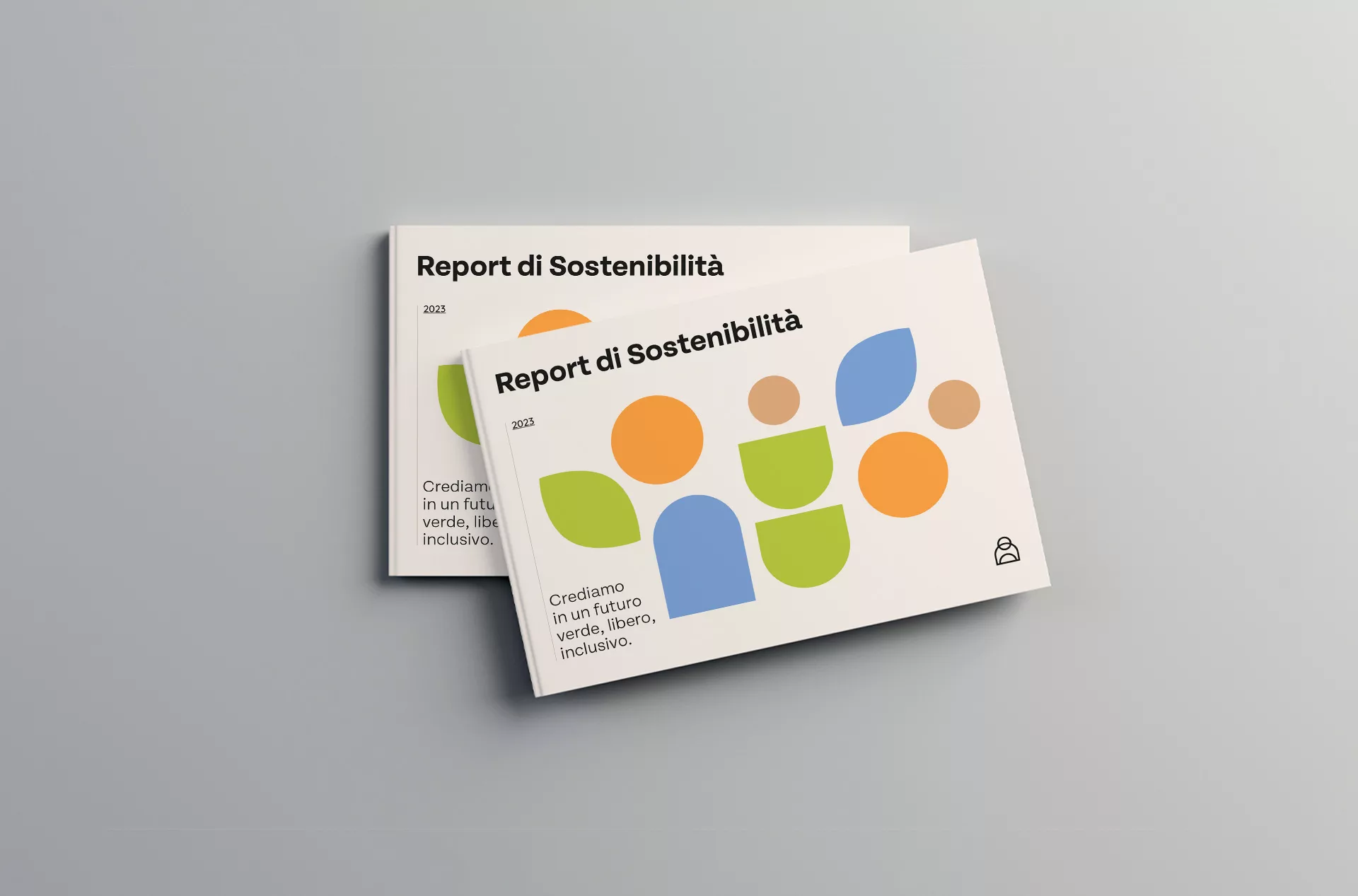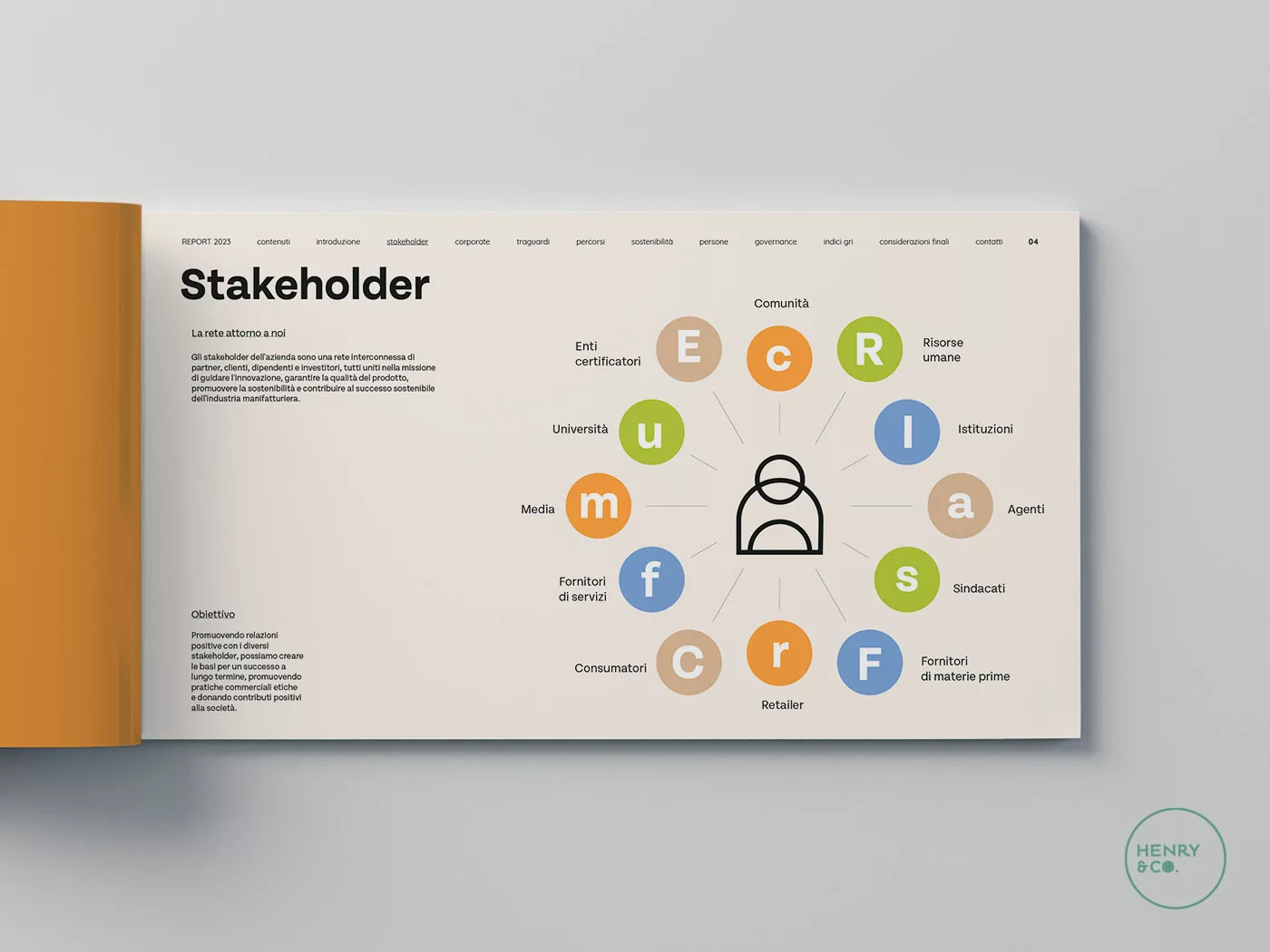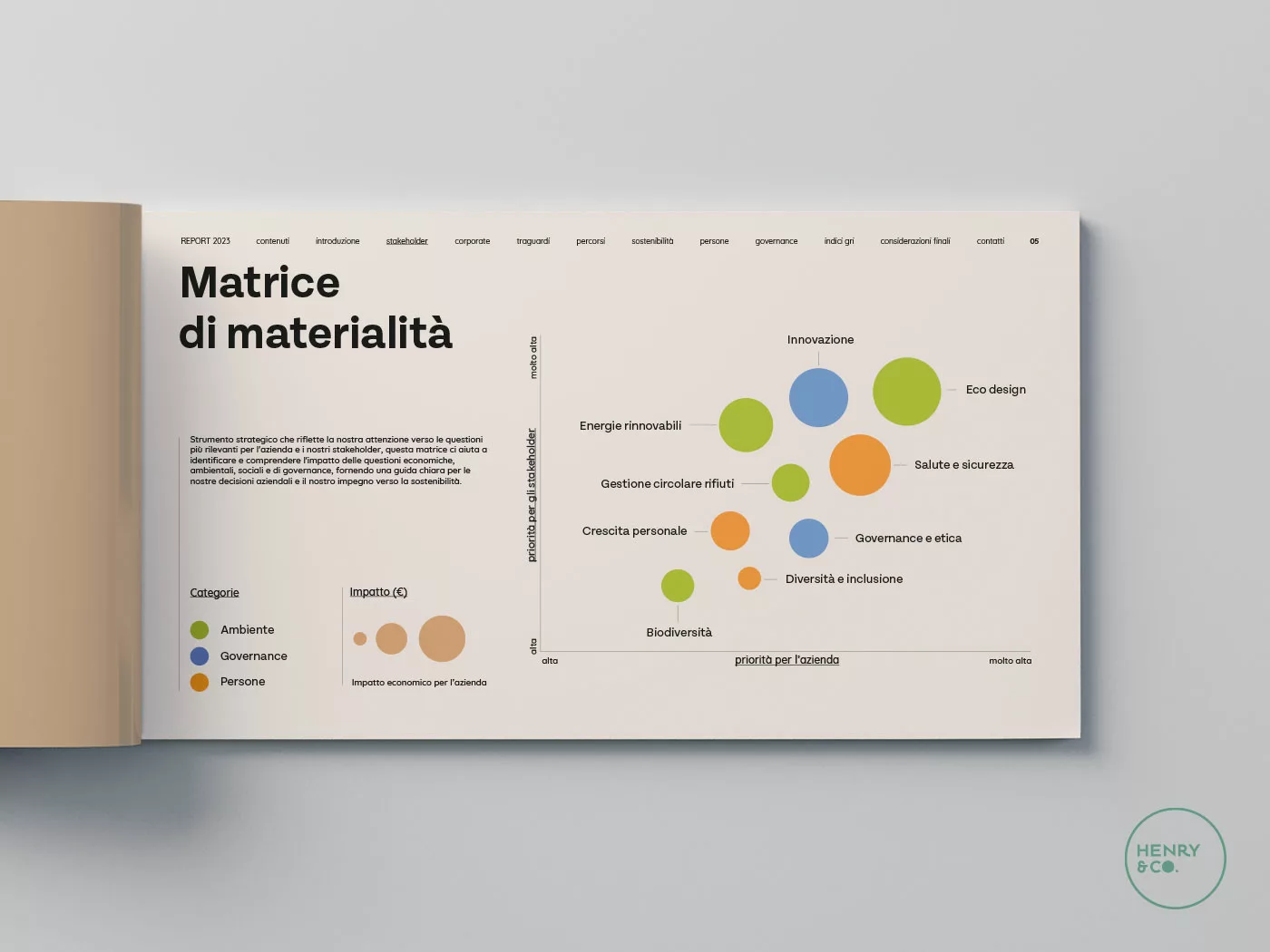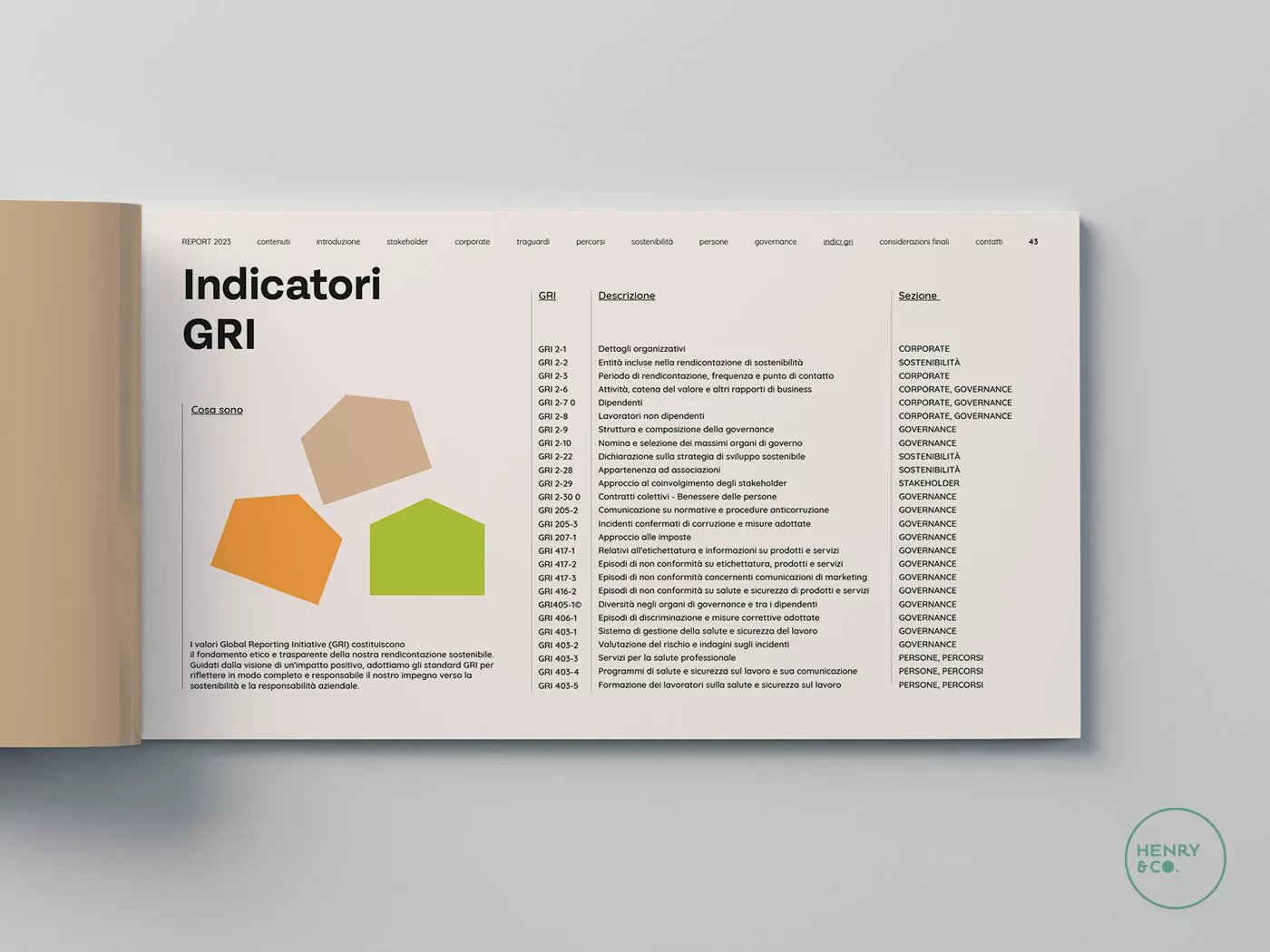From 2024, drafting a sustainability report is mandatory for all companies with more than 250 employees, a turnover exceeding 50 million euros, and a balance sheet of at least 25 million. The obligation follows the Corporate Sustainability Reporting Directive (CSRD), adopted by the European Parliament to make companies more transparent about their social and environmental impact. This will create a ripple effect, with more and more companies having to present their version annually.
HENRY & CO. provides support in drafting the sustainability report, through a document that examines the economic, social, and environmental impacts of the activity.
In this article, we will explain all the steps to respond transparently to stakeholder information needs, including through a clear presentation. Let’s get started!
Why draft a sustainability report?
A sustainability report is an essential tool for communicating an organization’s commitments, results, and impacts in relation to environmental issues and its impact on society. It is, therefore, a real report that aims to provide an overview of the company’s ESG initiatives.
What are the benefits of the report?
In reality, the sustainability report not only appears as a duty but also as a decision-making tool offering numerous benefits even for the company itself.

For all these processes, the sustainability report can be intimidating, but it is not so complex if you have the right partner. HENRY & CO. guides companies on the path towards the ecological transition, providing support even during the reporting phase thanks to a whole range of services, including:
- drafting the Sustainability Report under CSRD;
- layout and communication of the Sustainability Report.
FILL OUT THE FORM BELOW TO GET MORE INFORMATION ABOUT THIS SERVICE.
Regarding the benefits for the company, we can say:
- the sustainability report can improve the company’s reputation by demonstrating its commitment to sustainable and responsible practices;
- corporate social responsibility actions make it possible to attract new customers and increase loyalty levels;
- a sustainability report can facilitate access to funding and investments, attracting the interest of investors and financial institutions;
- writing the report can help identify opportunities for improving operational efficiency, reducing costs, and optimizing resources.
Which companies must draft a sustainability report?
As mentioned earlier, from 2024, drafting a sustainability report is mandatory for all companies with more than 250 employees, a turnover exceeding 50 million euros, and a balance sheet of at least 25 million. In general, however, this is a document that can be adopted by:
- large companies and multinationals
- companies with significant environmental impacts in the energy, natural resources, or manufacturing sectors
- publicly listed companies
- public entities
- SMEs looking to operate ethically, responsibly, and sustainably.
What are the guidelines for drafting a sustainability report?
Let’s start with an answer that will probably confuse you: as of today, there are no real guidelines for drafting the report. Reporting standards are varied and not always consistent, though efforts are underway to achieve uniformity thanks to EFRAG, which has been tasked by the European Commission with drafting European reporting standards, the ESRS.
At present, the most widely recognized guidelines are those of the Global Reporting Initiative (GRI), which offers a list of standards – GRI Standard – for reporting one’s impact on the community from an environmental, social, and governance (ESG) perspective.
Normally, chapters follow the internal focus areas deemed important by the company, such as personnel, relationships with suppliers, etc. There are no precise indications on the report length either.
What are the principles to follow when drafting the report?
The important thing is to respect the principles of:
- stakeholder inclusivity, where the organization identifies its stakeholders and describes the relationships and how they have responded to and met their expectations;
- materiality, to report on the concrete aspects and economic, environmental, and social impacts, or those that could materially influence stakeholders’ decisions;
- data accuracy and verifiability of the information to provide a transparent representation of results and developments;
- completeness to provide a comprehensive and coherent picture of the company’s sustainability actions and their impacts.
Who within the company should be involved in drafting the report?
The Sustainability Report requires cross-cutting skills and a broad understanding of the corporate context. All key company figures need to be involved to understand the systemic effects of sustainability initiatives. Depending on the organization and sector, there are several key players who must be engaged:
- Senior Management, i.e., CEO, directors, and other high-level executives responsible for the company’s strategic vision;
- Sustainability Manager, who, if present, leads sustainability initiatives, coordinates data collection, and prepares the report;
- Heads of various departments;
- the Finance Department for collecting and analyzing financial data related to sustainability;
- the Communication and Marketing Team, whose collaboration is necessary to communicate the sustainability report results, both internally and externally;
- Supply Chain Manager to have a view of the impact across the entire supply chain;
- Health and Safety Manager for data related to social sustainability;
- Human Resources Manager for employee well-being and training aspects;
- IT Manager for managing the information systems needed for data collection and analysis;
- external consultants involved in sustainability initiatives, if applicable.
Who to turn to for drafting a sustainability report?
A sustainability report is a detailed document that involves several actions (and time, as it takes 3 to 4 months to draft). Specifically, it is necessary to:
- create a stakeholder map;
- outline the company’s profile;
- collect and interpret the data;
- develop the materiality analysis;
- identify the company’s KPIs;
- draft the report according to the principles we have seen;
- take care of the document layout;
- communicate the sustainability report to the public.
Since this is delicate work, it is ideal to rely on an experienced team for drafting the sustainability report.
HENRY & CO. accompanies you throughout the certification process, from data collection to layout, in accordance with international indices and standards.
What are the key points to consider when drafting a sustainability report?
We have seen what a sustainability report is and the principles that guide its drafting. Now let’s look at the mandatory steps to consider when drafting the sustainability report.
1. What is stakeholder mapping?
Stakeholder mapping allows the company to identify key stakeholders and follow the appropriate engagement methods to obtain a materiality matrix that takes their interests into account.
Stakeholder mapping involves four steps:
- Identification: who are the people involved?
- Analysis: what are their roles and expectations?
- Priority: what value do the identified stakeholders have within the production and decision-making processes?
- Involvement: how involved are they, and what impact do the involved parties have?

2. The corporation: what is it and how to present it
The presentation of the company is essential to provide a complete picture of the operating context and its sustainability actions. The presentation section should, therefore, provide a comprehensive overview that includes:
- brief history of the company and its founding;
- mission and vision of the company, along with ethical principles and values (if there is one, it is always a good idea to include the company’s code of ethics as well);
- sustainability efforts and related statements and certifications, in addition to future goals;
- organizational chart of key company figures, describing the role of leadership in sustainability decisions;
- description of the core business to clearly and concisely explain the sector in which the company operates, the services and products it offers, etc.;
- overview of past sustainable projects providing examples of projects, key results, and progress, in addition to future goals.

3. What is the materiality matrix?
The materiality matrix is used to identify the most relevant action areas for the company and its stakeholders, focusing sustainable efforts on crucial issues. The matrix should therefore include:
- X-axis (Horizontal), which represents the impact on the company, where topics are listed and evaluated based on their impact on the company.
- Y-axis (Vertical), which represents the interest of stakeholders to provide an overview of their expectations.
At the intersection points of the two axes, topics considered “material” are positioned, meaning they are of interest to both parties. The points in the matrix can be differentiated by color or size to indicate the degree of materiality. Each point is then accompanied by labels and descriptions to support the entry.
3.1 What is double materiality?
A key element in modern sustainability reporting standards, as ESRS are, is double materiality, which refers to two distinct but interconnected aspects of sustainability reporting:
- financial materiality: focuses on how environmental, social, and governance (ESG) issues affect an organization’s financial performance. In other words, it considers how sustainability issues may have a direct economic impact on the organization, such as risks related to climate change or market opportunities tied to sustainable business practices.
- impact materiality: focuses on the impact that an organization’s activities have on the environment and society. For example, it might concern the effects of pollution caused by the company or its contribution to the well-being of local communities.
“Double materiality” requires companies to consider both the effects of ESG issues on their financial operations and the impact of their activities on the environment and society. This means that companies must report not only on how sustainability issues affect their economic performance but also on how their operations influence the external world.
The result is a more holistic and comprehensive framework to provide to stakeholders.

4. The indices: what to choose between GRI, ESRS, and EFRAG?
For accurate and transparent reporting, companies must rely on one or more recognized standards that provide detailed guidelines on content and organization of results. In this regard, GRI (Global Reporting Initiative), ESRS (European Single Reporting Format), and EFRAG (European Financial Reporting Advisory Group) are the most important indices to refer to.
In 2023, there was significant collaboration and alignment between the GRI Standards and ESRS. This means that companies already using the former will be well-prepared to meet the requirements of the ESRS.
EFRAG and GRI have worked together to ensure this alignment. This is because the ESRS will be mandatory for large companies and publicly listed companies in the EU starting in January 2024. From 2028, non-EU companies operating in Europe will also need to report their impacts using ESRS or equivalent standards.
Let’s briefly examine the standards listed below.
Global Reporting Initiative (GRI)
These are global guidelines for sustainability and corporate social responsibility reporting. Among the main indices, we have:
- GRI G4-1: Statement of Support for Sustainability from Top Management
- GRI G4-EN3: Total Water Consumption
- GRI G4-LA1: Total Number and Rate of Employee Turnover
- GRI G4-SO1: Assessment of Direct and Indirect Economic Impacts.

What are the European Single Reporting Formats (ESRS)?
The ESRS, which we have already discussed in this article, are indices for the presentation of both financial and non-financial information. They are a product of EFRAG, an institution aimed at providing technical advice on the adoption and application of international accounting standards in the EU.
Some of the indices included are:
- Information about the organization, such as its name, address, and business sector;
- Information on sustainability (ESG);
- Financial information.
What is the European Financial Reporting Advisory Group (EFRAG)?
EFRAG is a body that provides advice on accounting and financial reporting. While GRI and ESRS focus on sustainability, EFRAG has a broader emphasis on financial accounting. EFRAG includes:
- IAS (International Accounting Standards): adherence to and implementation of international accounting standards;
- Economic Impact Assessment: analysis of the economic impacts of business decisions and operations;
- Accounting Policy Advisory: providing accounting policy advice to businesses and regulatory bodies.
5. How is data collected?
The data to be collected for drafting an ESG report varies based on the indicators used, which will provide the KPIs to be considered. Therefore, stakeholders, including employees, customers, suppliers, local communities, and other stakeholders, must be involved in the data collection process.
Both quantitative and qualitative data need to be gathered, through the implementation of proper monitoring systems and by engaging various departments of the organization to obtain accurate data.
The responsibility for data collection for the sustainability report lies with the company, and it is a crucial process to allow for the accurate and clear drafting of the report.
6. What is the timeline for preparing a report?
Once the standards are defined, stakeholders identified, and data collected, it is finally possible to prepare the report. Writing the mandatory sustainability report takes about 2 months. The layout and design of the document can take an additional 2 to 4 weeks.
7. How to format a sustainability report? What layout? What cover?
The formatting of the sustainability report is essential to make the report readable and user-friendly. In this phase, it is important to define:
- Graphic style: the styles and templates to be used throughout the document are chosen, also incorporating images and white spaces for ease of reading;
- Cover: a cover is created that encapsulates the essence of the company and the core message of the document;
- Infographics and key points: To make the data presented in the report easier to understand, customized illustrations and infographics are created to improve readability;
- Photographs: selecting photos that provide an overview of the company and the context in which it operates, alternating them in various sizes (including full-page);
- Printing materials: choosing the materials to print the report on and the printing inks, considering the environmental impact.
Who produces the graphics and infographics for the sustainability report?
Special attention should be given to graphics and infographics during the drafting of the report, as they are crucial to making the report readable and summarizing key points.
But who produces these graphic contents?
There are communication and design agencies specializing in providing graphic and communication services. Ideally, you should look for an agency that has experience in sustainability or that is attentive to environmental issues.
Alternatively, another option is to seek sustainability consultants with graphic design skills.
HENRY & CO. offers both. We are the premier sustainable design and communication studio that specializes in assisting with the drafting of sustainability reports, from writing to layout.
Our graphic design experts, specifically trained in this area, take care of enhancing the report with the most suitable infographics and graphics.
8. What is Sustainability Certification support?
Sustainability Certification allows companies to certify their commitment to ESG standards.
The methodologies behind the evaluation are those established based on ISO/IEC 17021-1 standards for certification bodies of products and services accredited according to ISO/IEC 17065. The ESG-SDGs Rating standard gathers in a single standard the requirements that an organization or a product/service must meet to claim compliance with Environmental, Social, and Governance principles in achieving the SDGs.
To obtain the certification, companies must engage ESG-SDGs certified auditors to guide them through the certification process.
9. How should the summary manifesto be communicated to stakeholders?
The Sustainability Report is a public document that should be communicated to all stakeholders through a multichannel communication approach, using (at least) the following tools:
- The organization’s website;
- Social media profiles, newsletters, and other communication channels used by the company;
- Press office activities;
- Events, both live and streaming;
- Corporate materials to be provided to stakeholders.
How does HENRY & CO. support businesses in drafting their sustainability reports?
As we’ve seen, the sustainability report is a complex and detailed document that involves several stages, including:
- The preparation phase, which involves data collection and the definition of the company context and stakeholders;
- The drafting and production phase of the document;
- The dissemination phase and support with certification.

Precisely because of all these processes, the sustainability report may seem daunting, but it’s not as complex if you have the right partner by your side. HENRY & CO. supports businesses on their journey towards ecological transition, also providing assistance in the reporting phase through a range of services, including:
- Drafting the Sustainability Report (CSRD);
- Designing the Sustainability Plan;
- Formatting and communicating the Sustainability Report.
FILL OUT THE FORM BELOW TO GET MORE INFORMATION ABOUT THIS SERVICE.
